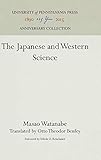The Japanese and Western Science / Masao Watanabe.
Material type: TextSeries: Anniversary CollectionPublisher: Philadelphia : University of Pennsylvania Press, [2016]Copyright date: ©1991Edition: Reprint 2016Description: 1 online resource (128 p.) : 45 illusContent type:
TextSeries: Anniversary CollectionPublisher: Philadelphia : University of Pennsylvania Press, [2016]Copyright date: ©1991Edition: Reprint 2016Description: 1 online resource (128 p.) : 45 illusContent type: - 9780812282528
- 9781512808094
- 509.52 19
- Q127.J3
- online - DeGruyter
- Issued also in print.
| Item type | Current library | Call number | URL | Status | Notes | Barcode | |
|---|---|---|---|---|---|---|---|
 eBook
eBook
|
Biblioteca "Angelicum" Pont. Univ. S.Tommaso d'Aquino Nuvola online | online - DeGruyter (Browse shelf(Opens below)) | Online access | Not for loan (Accesso limitato) | Accesso per gli utenti autorizzati / Access for authorized users | (dgr)9781512808094 |
Frontmatter -- Contents -- Foreword -- Translator's Preface -- Acknowledgments -- Introduction: Japan's Modern Century -- 1. From Samurai to Scientist: Yamagawa Kenjlrō -- 2. Japan Studies of Foreign Teachers in Japan: Investigations of the Magic Mirror -- 3. A Zoologist Fascinated by Japan: Edward Sylvester Morse -- 4. Response to a New Scientific Theory: Darwinism in the Early Meiji Era -- 5. Biology and the Buddhistic View of the Transience of Life: Oka Asajirō -- 6. Modern Science and the Japanese Conception of Nature: A Sketch -- 7. Overall Perspectives: Tasks for Today -- Epilogue to the English Edition -- Bibliography -- Index -- Backmatter
restricted access online access with authorization star
http://purl.org/coar/access_right/c_16ec
The Japanese first encountered Western scientific technology around 1543, when the Portuguese drifted ashore and left them firearms. For the next few centuries Japan's policy of national isolation severely limited contact with the West. In the middle of the nineteenth century, when Commodore Perry introduced the Japanese to a few of the West's technological achievements, they realized how vulnerable their technological ignorance made them and felt great pressure to master Western science as quickly as possible. In The Japanese and Western Science, Masao Watanabe succinctly examines the intersection of Western science and Japanese culture since Japan's opening to the West. Using case studies, including a Japanese scientist trained in the West and foreign teachers brought to Japan, he describes how the Japanese quickly and effectively accepted Western science and technology. Yet Japan, eager to catch up, sought for the fruits of science rather than its cultural and religious roots or the processes that allowed it to flourish. The author contends that this resulted in a lack of integration of the new science into Japanese culture with the resulting strains in people's lives, their education, in research, in international affairs, and in environmental pollution. The central three chapters focus on Darwin, how his views were introduced, what aspects were of most interest--survival of the fittest rather than the common origins of animals and humans--and how one Japanese biologist sought to blend social Darwinism and Buddhist ideas. In one of the summarizing chapters, Watanabe contrasts the Western and Japanese conceptions of nature, and points out that the latter has tended to make the Japanese rely on mother nature to cope with the effects of human actions, no matter what these might be. The book is the product of painstaking research and penetrating insight by a Japanese scholar who has firsthand knowledge of Western science and culture.
Issued also in print.
Mode of access: Internet via World Wide Web.
In English.
Description based on online resource; title from PDF title page (publisher's Web site, viewed 27. Sep 2021)


